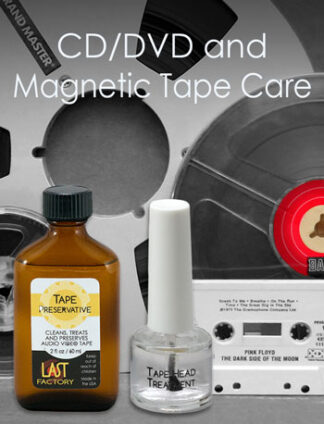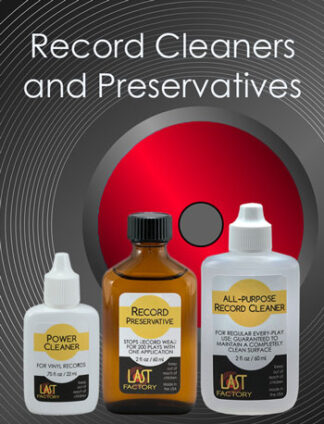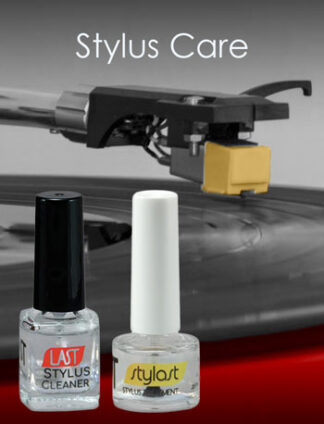LAST TAPE PRESERVATIVE
TECHNICAL PAPER by Walter Davies
Published in BROADCAST ENGINEERING, October 1987.
INTRODUCTION
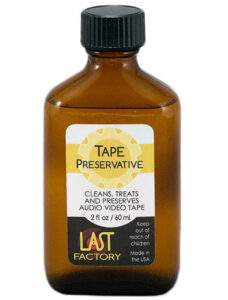 Magnetic tape is subject to two life-limiting phenomena. The first, those mechanical factors which cause physical wear of the tape. The second is hydrolysis, a process whereby the binder (which holds the magnetic oxide to the plastic support film) disassociates due to the atmospheric moisture and excessive temperature.
Magnetic tape is subject to two life-limiting phenomena. The first, those mechanical factors which cause physical wear of the tape. The second is hydrolysis, a process whereby the binder (which holds the magnetic oxide to the plastic support film) disassociates due to the atmospheric moisture and excessive temperature.
LAST TAPE PRESERVATIVE for magnetic tape is aimed directly at the problems and conditions which determine the ultimate use life of magnetic media.
HYDROLYSIS & TEMPERATURE
Hydrolysis is a chemical reaction wherein atmospheric moisture combines with the polyester component of the media binder. This breaks the bond holding the constituent parts of the polyester together and yields an alcohol and an acid. The rate of the reaction is a direct function of the concentration of moisture and the temperature. When the point is reached where 20% of the binder has been affected by hydrolysis, massive oxide shedding is imminent. When binder failure becomes extensive, hydrolysis can no longer be reversed, and the media and its information is lost.
STORAGE CONDITIONS
Ideal storage conditions for magnetic media are 65 degrees F. and 40% relative humidity. However, most users of magnetic media are not able to store their material under ideal or archival conditions. LAST TAPE PRESERVATIVE treats the media so as to act as a barrier and thereby substantially slow down the diffusion of moisture into the binder. At the same time, it acts to slow the migration and transpiration of plasticizer out of the media. Proper environmental controls are still desirable, but use of LAST TAPE PRESERVATIVE considerable increases the size of the storage “safety window”. *
A determination of the long term stability of treated media under different storage conditions is in process. Preliminary indications point to a substantial increase in use life even under less than ideal storage conditions.
MECHANICAL FACTORS
There are several mechanical factors which bear directly upon the longevity of magnetic media. Testing has been conducted in three areas which affect tape life.
The abrasivity and coefficient of friction of treated and untreated tapes were examined. The ability of tape to withstand the abrasion caused by heads and guides was also tested.
TESTING
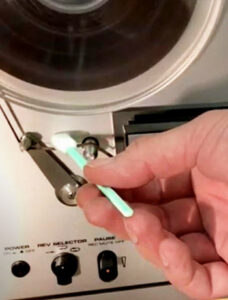 In a comparison between sections of tape from the same reel, the following mechanical parameters have been measured.
In a comparison between sections of tape from the same reel, the following mechanical parameters have been measured.
The abrasivity tests were conducted according to American Standards Institute Document X3B6-601, dated 16 September 1981. This document describes test methods and procedures used in conducting these tests. The results are as follows. The treated tape samples show a reduction in abrasivity of between 30 and 40 percent. The coefficient of friction (both static and dynamic) of treated and untreated samples of various tapes was measured using a Tental Model T2-H2O- 2 tape tension meter. The reduction in friction coefficient varies over a range of 5 to 40 percent depending upon the oxide/binder formulation. Most of the samples ran 15 to 25 percent less than their untreated counterparts.
The abrasion wear life test has two components. A signal is recorded onto the media. Then a bearing surface is passed repeatedly over the surface. At specific intervals the signal is read. Failure is defined as when (1) the strength of the recorded signal drops by a specified amount or, (2) the media begins to separate from its plastic film backing. There is a large spread in the results which appears to be related to the type of oxide used and its related binder. Very smooth, highly polished surfaces start with an untreated sample base line which has twice the life of standard gamma ferric oxide formulations. Most importantly, all treated samples had from two to eight times the lifetime of untreated tape.
A series of tests conducted by a different organization yielded the same wear results. In addition, Intermodulation Distortion was measured on comparative treated and untreated samples of tape. Measured I.M. is consistently 2 or 3 dB lover on the treated samples and a substantial 6 dB lower on one type of tape.
MAGNETIC PERFORMANCE
Preliminary testing indicates improvements in the s/n ratio and high frequency response. All of these results have strong implications in the analog domain.
CONCLUSIONS
LAST TAPE PRESERVATIVE offers substantial increases in the life of magnetic media. Its use addresses problems in environmental storage conditions and mechanical wear factors. Ongoing testing indicates improvements in performance characteristics which are of direct interest to tape users recording in the analog domain. This increase in life and performance is achieved at modest cost.
The treatment can be applied in the field or at point of manufacturer and is safe and effective for all magnetic media.
* Davies, W.E. “Preserving Magnetic Tape” BROADCAST ENGINEERING October 1987


